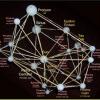AT1 antagonism looks interesting as an anti aging approuch, i recently came across those studies when looking into angiotensin.
Disruption of the Ang II type 1 receptor promotes longevity in mice.
Benigni A, Corna D, Zoja C, Sonzogni A, Latini R, Salio M, Conti S, Rottoli D, Longaretti L, Cassis P, Morigi M, Coffman TM, Remuzzi G.
Mario Negri Institute for Pharmacological Research, Via Gavazzeni 11, Bergamo, Italy. abenigni@marionegri.it
Abstract
The renin-angiotensin system plays a role in the etiology of hypertension and the pathophysiology of cardiac and renal diseases in humans. Ang II is the central product of this system and is involved in regulating immune responses, inflammation, cell growth, and proliferation by acting through Ang II type 1 receptors (AT1 and AT2). Here, we show that targeted disruption of the Agtr1a gene that encodes AT1A results in marked prolongation of life span in mice. Agtr1a-/- mice developed less cardiac and vascular injury, and multiple organs from these mice displayed less oxidative damage than wild-type mice. The longevity phenotype was associated with an increased number of mitochondria and upregulation of the prosurvival genes nicotinamide phosphoribosyltransferase (Nampt) and sirtuin 3 (Sirt3) in the kidney. In cultured tubular epithelial cells, Ang II downregulated Sirt3 mRNA, and this effect was inhibited by an AT1 antagonist. These results demonstrate that disruption of AT1 promotes longevity in mice, possibly through the attenuation of oxidative stress and overexpression of prosurvival genes, and suggests that the Ang II/AT1 pathway may be targeted to influence life span in mammals.
Angiotensin receptors as determinants of life span.
Cassis P, Conti S, Remuzzi G, Benigni A.
Mario Negri Institute for Pharmacological Research, Via Gavazzeni, 11, 24125 Bergamo, Italy.
Abstract
Angiotensin II (Ang II), the central product of renin-angiotensin system, has a role in the etiology of hypertension and in pathophysiology of cardiac and renal diseases in humans. Other functions of Ang II include effects on immune response, inflammation, cell growth and proliferation, which are largely mediated by Ang II type 1 receptor (AT(1)). Several experimental studies have demonstrated that Ang II acts through AT(1) as a mediator of normal aging processes by increasing oxidant damage to mitochondria and in consequences by affecting mitochondrial function. Recently, our group has demonstrated that the inhibition of Ang II activity by targeted disruption of the Agtr1a gene encoding Ang II type 1A receptor (AT(1A)) in mice translates into marked prolongation of life span. The absence of AT(1A) protected multiple organs from oxidative damage and the alleviation of aging-like phenotype was associated with increased number of mitochondria and upregulation of the prosurvival gene sirtuin 3. AT(1) receptor antagonists have been proven safe and well-tolerated for chronic use and are used as a key component of the modern therapy for hypertension and cardiac failure, therefore Ang II/AT(1) pathway represents a feasible therapeutic strategy to prolong life span in humans.
EMBO Mol Med. 2010 Jul;2(7):247-57.
Angiotensin II revisited: new roles in inflammation, immunology and aging.
Benigni A, Cassis P, Remuzzi G.
Mario Negri Institute for Pharmacological Research, Bergamo, Italy.
Abstract
That the renin-angiotensin system (RAS) is involved in regulation of blood pressure, vasoconstriction, sodium intake and potassium excretion is well established. Studies in the last few years have however documented new roles for this molecule as a pro-inflammatory molecule and more recently as a possible pro-fibrotic agent that contributes to progressive deterioration of organ function in disease. Binding of Ang II to its receptors (in particular AT(1)) mediates intracellular free radical generation that contributes to tissue damage by promoting mitochondrial dysfunction. Blocking Ang II signalling protects against neurodegenerative processes and promotes longevity in rodents. Altogether these findings open the unanticipated perspective for exploring Ang II signalling in therapeutic interventions in inflammatory diseases and aging-related tissue injury. This review extends from the discovery of Ang II and its implications in renal and cardiovascular physiology to cover the roles of the system in inflammation, tissue injury, autoimmunity, oxidative stress and aging.
More info about the klotho gene:Nephrol Dial Transplant. 2010 Sep 2. [Epub ahead of print]
Angiotensin II blockade upregulates the expression of Klotho the anti-ageing gene, in an experimental model of chronic cyclosporine nephropathy.
Yoon HE, Ghee JY, Piao S, Song JH, Han DH, Kim S, Ohashi N, Kobori H, Kuro-O M, Yang CW.
1Division of Nephrology, Department of Internal Medicine, Incheon St. Mary's Hospital, College of Medicine, The Catholic University of Korea, Incheon, South Korea.
Abstract
BACKGROUND: The Klotho gene plays a role in suppressing ageing-related disorders. It is suggested that activation of renin-angiotensin system (RAS) or oxidative stress suppresses Klotho in the kidney. This study evaluated the association between Klotho expression and RAS in cyclosporine (CsA)-induced renal injury.
METHODS: Chronic CsA nephropathy was induced by administering CsA (30 mg/kg) to mice on a low-salt diet (LSD) for 4 weeks. A normal-salt diet (NSD) was used as the control. Reverse transcription-polymerase chain reaction, western blot and immunohistochemistry were performed for Klotho and intrarenal RAS activity was measured using immunohistochemistry for angiotensinogen and renin. Oxidative stress was measured with urinary excretion of 8-hydroxy-2'-deoxyguanosine (8-OHdG).
RESULTS: CsA treatment decreased Klotho mRNA and protein in mouse kidney in a dose-dependent and time-dependent manner, but a concurrent treatment with losartan, an angiotensin II type 1 (AT1) receptor blocker, reversed the decrease in Klotho expression with histological improvement. This finding was more marked in the LSD than the NSD. Klotho expression was correlated with angiotensinogen and renin expression, tubulointerstitial fibrosis score and urinary 8-OHdG excretion.
CONCLUSIONS: Angiotensin II may play a pivotal role in regulating Klotho expression in CsA-induced renal injury. AT1 receptor blocker may inhibit the ageing process by decreasing oxidative stress caused by CsA.
http://www.imminst.o...4&t=7759&hl=&s=
More information in general about Angiotensin II AT1 antagonists is in my thread on mind and muscle:
http://www.mindandmu...showtopic=43119
Edited by medievil, 19 September 2010 - 06:40 PM.























































